Annual Report 2019–20: Building tomorrow’s public service today



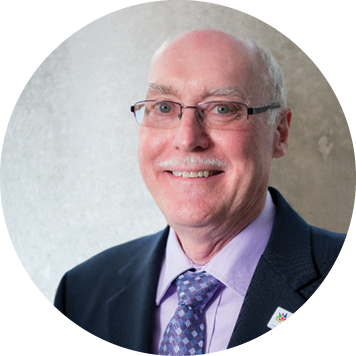
Message from the Commissioners
Each year, the Public Service Commission of Canada is pleased to report to Parliament on the health and integrity of the staffing system and the non-partisanship of the federal public service. Although the COVID-19 pandemic represented only a small part of 2019–20, it has overshadowed the events of the last year, and it will have a profound influence on our future. We would like to recognize the federal public service’s exceptional response to an unprecedented challenge. It has been inspiring to see public servants act with agility and dedication in serving Canadians during these trying times.
Like all departments and agencies, the Public Service Commission was called upon to adapt quickly and to find new ways to support the people it serves. Through responsive policy and service innovation, it has helped departments and agencies meet their urgent hiring needs. Difficult times can test a policy and challenge the need for certain rules. Our staffing policy framework has met this test, providing departments and agencies with the flexibility to meet unparalleled demands. The pandemic has also revealed the limits of this discretion, and highlighted that even more flexibilities would be welcome to those on the front lines during times of crisis.
As we look to the future, we hope lessons will be drawn about the tremendous potential of virtual work to provide opportunities for underrepresented communities and to increase the federal public service’s regional presence. We need to embrace the value of diversity and recognize that the barriers we thought existed in virtual work are surmountable. We must strive to accelerate the development of the full range of digital options and technological advances in order to remove employment barriers, improve our ability to reach talent and reduce the time it takes to hire.
Events from the past year have reminded us that systemic racism and discrimination are still very present in our daily lives and in our institutions. Black and racialized communities, Indigenous peoples and persons with disabilities continue to be harmed by this damaging reality. The Public Service Employment Act recognizes that “Canada will […] continue to gain from a public service that strives for excellence, that is representative of Canada’s diversity and that is able to serve the public with integrity.” Charged with this responsibility, the Public Service Commission will do everything in its power to seek out and eliminate all biases and barriers embedded in the public service hiring culture.
We are pleased that Ms. Fiona Spencer, our newest Commissioner, has joined us in pursuing these challenges. As former Merit Commissioner for the province of British Columbia, and with 30 years of experience as a federal public servant, Ms. Spencer is a tremendous addition to our team. Her leadership, integrity and dedication are already greatly appreciated.
Patrick Borbey
President
Fiona Spencer
Commissioner
D. G. J. Tucker
Commissioner

Building a future-ready public service
Act population

Text Alternative
| Public Service Employment Act population as of March 31, 2020 | |||
|---|---|---|---|
| Tenure | Population | Percentage of population | Year-over-year change in population (percentage) |
| Indeterminate | 196 915 | 84.5% | + 4.8% |
| Term | 19 979 | 8.6% | + 13.4% |
| Casual | 9 072 | 3.9% | - 1.0% |
| Student | 7 010 | 3.0% | + 8.0% |
| Total | 232 976 | 100% | + 5.4% |
Canadians want to serve. In 2019–20, 858 128 applications were submitted to the 3 357 federal public service job postings open to all Canadians. This interest resulted in 61 794 external hires into departments and agencies subject to the Public Service Employment Act. This was an increase of 3.5% from the previous year, and represents the highest level of hiring in the last 10 years. The total federal public service population increased by 5.4% as of March 31, 2020. This continues a steady increase over the last 6 years, from 195 252 in 2014–15 to 232 976 this year.
Student hiring, an important source of renewal for the public service, also saw a considerable increase in 2019–20, reaching its highest level in the past 10 years.
The number of former students recruited into full-time positions in the federal public service also increased last fiscal year: 4 271, or 16.3% of external indeterminate and term hires had previous experience under a federal student employment program.
hiring activity

Text Alternative
| 2019-20 total hiring activity | ||
|---|---|---|
| Total | Total hiring: 61 794 | Change since last year 3.5% |
| Indeterminate | 11 360 | 2.9% |
| Term | 14 836 | 8.7% |
| Casual | 20 464 | 4.5% |
| Student | 15 134 | 11.3% |
| Student breakdown | ||
| Federal Student Work Experience Program | 9 423 | 17.1% |
| Co-op/Internship Program | 5 626 | 4.5% |
| Research affiliate program | 85 | 49.4% |
In contrast to steady growth in many areas of hiring, the Public Service Commission of Canada’s 2019–20 Post-Secondary Recruitment campaign saw a decrease of 17.9% compared to the previous year, with 657 hires.
Staffing within the public service, including acting appointments, promotions and lateral movements, did not change significantly as compared to the previous year. While these appointments are important for developing and retaining employees, the rate of internal mobility continues to be high, with over a quarter (27%) of employees changing jobs within the year.
There were 756 new indeterminate executive appointments in departments and agencies subject to the Public Service Employment Act. Of these, 90.5% (684) were internal to the public service, similar to the percentage in previous years.
The high rate of internal mobility reflects the many career development opportunities available to federal public servants in various departments and agencies. However, we must not lose sight of the value of attracting external talent with new skills and diverse perspectives to the federal public service.

Text Alternative
Internal mobility rates over the past 6 years (percentage) |
||||||
|---|---|---|---|---|---|---|
Fiscal year |
2014 to 2015 |
2015 to 2016 |
2016 to 2017 |
2017 to 2018 |
2018 to 2019 |
2019 to 2020 |
Promotion Rate |
6.1% |
7.4% |
9.3% |
10.6% |
12.5% |
12.6% |
Acting Appointment Rate |
7.8% |
8.5% |
6.6% |
6.7% |
7.6% |
8.5% |
Lateral Movement Rate |
8.9% |
10.5% |
10.2% |
11.3% |
11.7% |
11.5% |
While the full effect of the pandemic on public service hiring remains to be seen, hiring patterns and trends are expected to shift. One indication of this shift is the number of students hired for the summer season, which represents the vast majority of student placements each year. Early evidence shows these hires are down significantly in 2020 as compared to previous years.
To quickly deliver crucial pandemic-related benefits and services to Canadians, Employment and Social Development Canada and Service Canada increased capacity on the frontlines and in other critical functions by drawing on all available staffing mechanisms. This included:
- redeploying almost 3 000 staff from less critical activities to help deliver Employment Insurance benefits and the new Canada Emergency Response Benefit
- setting up a new 1 500-person virtual call centre in just 9 days to handle the spike in call volumes and respond to more than 30 000 calls a day
- hiring students through the Federal Student Work Experience Program (including the Employment Opportunity for Students with Disabilities and the Indigenous Student Employment Opportunity programs), a valuable pool of workers who provided much-needed capacity to the virtual call centre
Responding to the pandemic
To support Canadians, departments and agencies rapidly mobilized resources in responding to COVID-19. This tested the hiring flexibility provided by the New Direction in Staffing — the policy framework that sets out rules for public service hiring. The framework allowed departments and agencies to recruit rapidly so as to provide critical services to Canadians.
At the Public Service Commission, we adapted our services to react to the pandemic and to assist departments and agencies in meeting urgent hiring needs. We put in place temporary policy measures and supporting guidance to provide more flexibility to departments and agencies in assessing second language requirements. We also launched a new test of second-language oral proficiency that enables candidates to be assessed from their homes, as an alternative to in-person testing. As these measures were put in place quickly, we are now consulting departments and agencies to address any limitations and to adapt the measures to meet departmental needs.
We also supported Health Canada’s National COVID-19 Volunteer Recruitment Campaign, building and managing an inventory of close to 55 000 volunteers to help the federal, provincial and territorial governments during the pandemic. We identified and referred volunteers, and rapidly developed new tools to process requests for volunteers and referrals.
Departments and agencies demonstrated collective resilience in hiring crucial resources during the pandemic. However, there are still lessons to be learned about recruitment during an emergency crisis, and indications that managers need more flexibility for temporary hiring during emergencies.

Hiring for the future
The COVID-19 pandemic forced a paradigm shift: the federal public service had to immediately adopt tools and practices that were once thought of as the future of work. We had to quickly implement digital technology solutions and rapidly learn to work in a new, virtual environment. Fortunately, like many departments and agencies, we were already working on projects to better incorporate digital technology into our processes and tools. The pandemic was an accelerator, pressing us to innovate from this existing foundation at unprecedented speeds.
Before the pandemic, the federal public service was already increasing its use of technology in hiring. Departments and agencies were starting to embrace digital tools to hire and assess scarce and in-demand skills, to make the recruitment process more efficient and to onboard new talent.
Employment and Social Development Canada, in collaboration with the Public Service Commission, undertook a study on using algorithms to help screen candidates in selection processes with many applicants. During the first phase of this study, the team tested algorithms that informed human decision-making. Preliminary results were promising, but more work remains. During the second phase of this research project, continued testing will ensure that algorithmic screening is technically feasible and does not lead to bias in the recruitment process.
To decrease time to staff and improve the job seeker experience, Agriculture and Agri-Food Canada implemented a collaborative staffing approach for high-volume staffing needs, developing talent pipelines for several of the most-staffed groups in the department. These recruitment campaigns are promoted through many channels (social media, professional networks, in-person events) and are designed to meet a variety of similar needs by focusing on core competencies rather than specific skills and experience. A dedicated team administers virtual assessment tools such as unsupervised internet testing and email exams, eliminating time-consuming duties (like scheduling and test administration) associated with in-person assessments. Hiring managers have the flexibility to then assess position-specific qualifications, and can select candidates when they need them. Using this approach, pools of qualified candidates have been created in as little as 5 weeks.
We are drawing on lessons learned from these and other initiatives to transform the public service recruitment system. With the GC Jobs Transformation project, we are building a new system that will:
- improve the job search and application process for all Canadians
- reduce time to staff and help hiring managers to quickly find skilled employees
- contribute to a representative public service
Infrastructure Canada’s human resources team is hiring faster
Infrastructure Canada’s new collective staffing team was instrumental in reducing time to staff. In 2019–20, an external process for junior analyst positions took 85 calendar days, from the date the poster was launched to the creation of a pool of candidates. The team was sub-delegated staffing authority, and took the lead in most decision-making; these factors greatly expedited both internal and external staffing processes and contributed to their success. Other factors enabling the team to hire faster include:
- a thorough planning phase, including consultation and collaboration with hiring managers to ensure that their needs were met
- the use of standardized assessment tools
- in-depth post-mortems following each process to determine areas for future improvement
This year, we launched an agile procurement process for the GC Jobs Transformation project in collaboration with Public Services and Procurement Canada, and held discussions with recruitment industry leaders. Throughout this process, we will conduct hands-on testing of potential recruitment solutions with participating departments and agencies to provide federal employers, and Canadians, with a system that is inclusive, effective and adaptable.
Although the drive to modernize is critical, we must not lose sight of the full range of recruitment options. In 2019–20, face-to-face events continued to resonate with job seekers and hiring managers alike. Vancouver’s Impact Career Fair aligned job seekers with employers who shared their values. We partnered with Public Services and Procurement Canada at the event to show junior and mid-level job seekers the benefits of serving the public.

Text Alternative
Median time to staff for departments and agencies subject to the Public Service Employment Act | ||
|---|---|---|
Fiscal year |
Internal time to staff |
External time to staff |
2016 to 2017 |
175 days |
188 days |
2017 to 2018 |
180 days |
194 days |
2018 to 2019 |
176 days |
186 days |
2019 to 2020 |
175 days |
203 days |
In collaboration with the University of British Columbia, Fisheries and Oceans Canada and 7 other government departments hosted a Government of Canada speed-staffing event in Vancouver. As a result, 221 applications were received, and 23 individuals were hired.
While these processes highlight a range of recruitment options, traditional staffing approaches, focusing more on process than on results, continue to be the norm. Standard processes are often drawn out by lengthy and complicated job advertisements and excessive requirements. Assessment strategies that follow a set formula (written test, interview and reference check) often lead to long and complex processes at the expense of a quality candidate experience.
Unfortunately, in 2019–20, the median time to hire for external advertised processes increased by 17 days, with recruitment taking close to 7 months. Departments and agencies must do more to transform recruitment and reduce their time to staff. We are committed to collaborating with our partners to enable this transformation.
Persons with a priority entitlement and veterans
Occasionally, a public servant’s life changes drastically. An employee may have to take an extended leave of absence and then return to work. A spouse may need to re-locate for their job, and find themselves on the other side of the country… or world! A Canadian Armed Forces member may no longer be able to perform their duties for a medical reason. Priority entitlements help people who experience career changes because of these types of life events.

Persons with a priority entitlement are talented and experienced individuals who can fill positions very quickly; they represent an effective solution to a hiring manager’s staffing needs. They often have a wealth of experience, skills and abilities, and range from entry-level to the executive group. Yet, despite an increase in overall public service hiring in 2019–20, only 561 persons with a priority entitlement were appointed, 22% less than in the previous year. This continues a 4-year decline in the number of appointments of persons with a priority entitlement, a noteworthy trend because managers must hire a qualified person with a priority entitlement before all others. One factor contributing to this decline may be the changing makeup of the priority population.
Over the past several years, there has been a profound shift in the composition of the priority population. In 2013–14, surplus public servants represented 18% of the priority population, whereas veterans and RCMP members released on medical grounds represented 6%. Six years later, in 2019–20, veterans and RCMP members released on medical grounds represented 38% of the priority population, whereas surplus public servants represented only 1.5%.
population and appointments Footnote 4
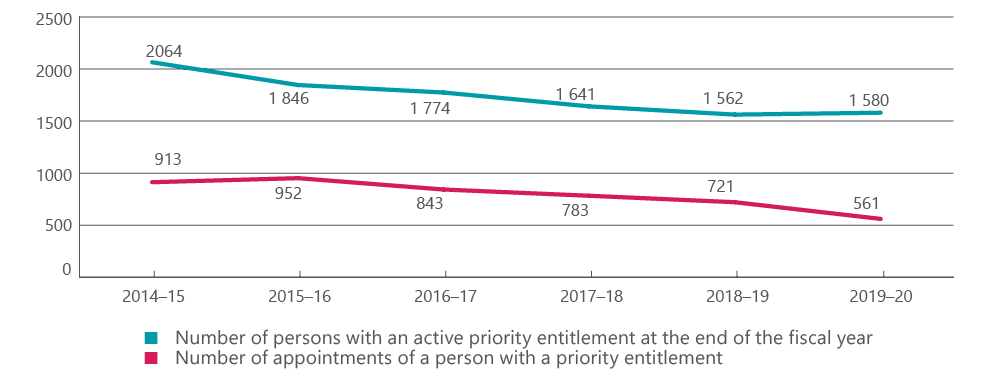
Text Alternative
Priority entitlements: population and appointments |
||||||
|---|---|---|---|---|---|---|
Fiscal year |
2014 to 2015 |
2015 to 2016 |
2016 to 2017 |
2017 to 2018 |
2018 to 2019 |
2019 to 2020 |
Number of persons with an active priority entitlement at the end of the fiscal year |
2 064 |
1 846 |
1 774 |
1 641 |
1 562 |
1 580 |
Number of appointments of a person with a priority entitlement |
913 |
952 |
843 |
783 |
721 |
561 |
appointments of veterans

Text Alternative
| Priority entitlements: appointments of veterans | ||
|---|---|---|
| Total | Total appointments of : 385 | Change since last year 19.5% |
| Priority entitlement | 158 | 30.1% |
| Mobility | 134 | 0% |
| Preference | 93 | 21.2% |
The population of medically released veterans increased to 595 individuals as of March 31, 2020, making them the largest group of persons with a priority entitlement. In 2019–20, 158 medically released veterans were appointed as a result of a priority entitlement, a decrease of 30% from the previous year.
In addition to the priority entitlement for medically released veterans, 2 more mechanisms support hiring veterans for 5 years after their release. A preference in external recruitment means that qualified veterans must be hired ahead of other candidates. A mobility provision means that qualified veterans and Canadian Armed Forces members are also included in internal staffing as though they were already public servants. In 2019–20, the number of mobility appointments of veterans did not change, and preference appointments saw a decrease of 21.2% compared to the previous year.
The federal public service must do more to employ veterans who want to continue to serve Canadians after their military career. This year, in collaboration with Veterans Affairs Canada, and with the support of the Department of National Defence and the Canadian Armed Forces, we evaluated the implementation of the provisions in the Veterans Hiring Act to support veteran hiring across the federal public service.
The evaluation found that veterans and eligible Canadian Armed Forces members face barriers to finding public service jobs. These barriers include a lack of understanding and knowledge of:
- the provisions found in the Veterans Hiring Act
- available support
- federal public service job opportunities
- how military expertise and competencies line up with federal public service occupational classifications
Connecting veterans and managers
Employment and Social Development Canada hosted 2 joint 1-on-1 recruitment events for hiring managers, veterans, Canadian Armed Forces members, their partners, surviving spouses and common-law partners. Participants met informally with hiring managers and discussed hiring opportunities. The events helped managers recognize and connect with this group’s skills and experience, while helping veterans to better understand the job opportunities that were available to them. These events have grown in size, and expanded to include Public Services and Procurement Canada and Shared Services Canada. Based on the 2 events held in 2019, 30 appointments were made.
Fisheries and Oceans Canada, Natural Resources Canada, Shared Services Canada and the Correctional Service of Canada hosted an interdepartmental job fair for veterans. The event included networking and interviews, with 122 participants and 26 hiring managers attending. As a result, 31 participants engaged in 1-on-1 interviews, and 5 people were hired.
These events show that taking a more personal approach with veterans can lead to positive results.
We are committed to working with our partners to build understanding and increase awareness of Veterans Hiring Act provisions among public service hiring managers and human resource advisors. We are also committed to providing veterans and Canadian Armed Forces members with the support they need. As part of this support, we provide the services of 2 veteran advisors. Now public servants, these advisors are veterans themselves, who previously had a priority entitlement for medically released Canadian Armed Forces members. They provide specialized guidance and advice to former Canadian Armed Forces members with a priority entitlement on policies, practices and procedures related to priority entitlements. They also draw on a shared vocabulary and their own experience and knowledge to explain how the priority system works, and consult with veterans on ways to improve our services.
An inclusive public service
The strength of diversity

Although we applaud efforts across the public service to increase diversity, the public service as a whole must do better. While it is encouraging to see members of visible minorities apply at a higher rate than their workforce availability, we need to address the fact that Indigenous peoples and persons with disabilities continue to apply to federal public service jobs at rates below their workforce availability. We will also continue to explore the lower promotion rates of Indigenous peoples and persons with disabilities.
The federal public service must continue to expand its understanding of the challenges faced by employment equity groups, and of the opportunities a diverse workforce offers. This involves building a deeper understanding of differences within groups, and of intersections with identity factors such as race and gender.
Beyond building this deeper understanding of employment equity groups, the Public Service Commission of Canada continues to encourage and promote positive steps that can be taken to make the public service more diverse and inclusive. One way to increase access to diverse pools of candidates is to open jobs to people from outside the public service. In 2019–20, the proportion of jobs open to all Canadians, a factor that is essential to increasing representation, was at its highest since 2010–11, at a 45% share of all job postings. This is an important continuing trend: making government jobs available to the public while renewing our ranks with a diverse set of skills and perspectives.

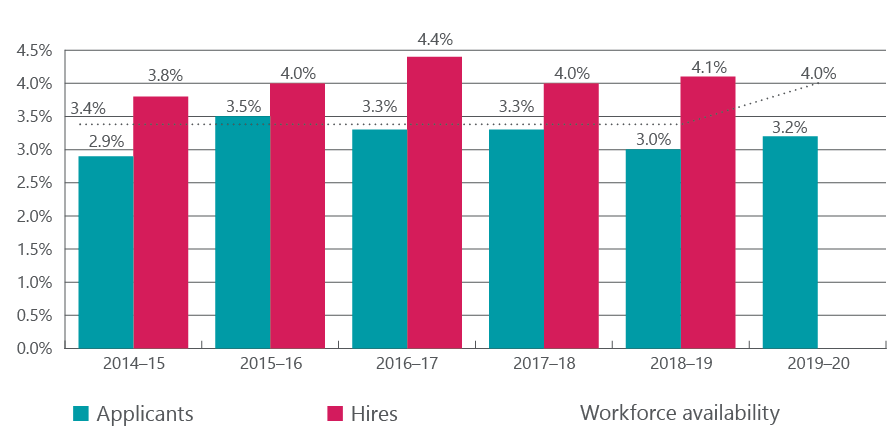
Text Alternative
Indigenous peoples applicants to advertised processes and hires compared to workforce availability (percentage) |
||||||
|---|---|---|---|---|---|---|
Fiscal year |
2014 to 2015 |
2015 to 2016 |
2016 to 2017 |
2017 to 2018 |
2018 to 2019 |
2019 to 2020 |
Applicants |
2.9% |
3.5% |
3.3% |
3.3% |
3.0% |
3.2% |
Hires |
3.8% |
4.0% |
4.4% |
4.0% |
4.1% |
- |
Workforce availability |
3.4% |
3.4% |
3.4% |
3.4% |
4.0% |
4.0% |
| Subgroup |
2018–19 applicants to external advertised processes |
2018–19 hires |
2019–20 applicants to external advertised processes |
2019–20 hires * |
|---|---|---|---|---|
| Inuit | 3.8% | 4.2% | 3.9% | - |
| Métis | 41.0% | 39.5% | 40.8% | - |
| North American Indian / First Nation | 46.5% | 38.0% | 48.0% | - |
| Other | 8.7% | 18.2% | 7.4% | - |

Text Alternative
Persons with disabilities applicants to advertised processes and hires compared to workforce availability (percentage) |
||||||
|---|---|---|---|---|---|---|
Fiscal year |
2014 to 2015 |
2015 to 2016 |
2016 to 2017 |
2017 to 2018 |
2018 to 2019 |
2019 to 2020 |
Applicants |
2.3% |
2.7% |
2.7% |
2.9% |
2.7% |
3.0% |
Hires |
3.5% |
3.3% |
3.8% |
3.6% |
3.7% |
- |
Workforce availability |
4.4% |
4.4% |
4.4% |
4.4% |
9.0% |
9.0% |
| Subgroup |
2018–19 applicants to external advertised processes |
2018–19 hires |
2019–20 applicants to external advertised processes |
2019–20 hires * |
|---|---|---|---|---|
| Blind or visual impairment | 4.6% | 4.9% | 4.7% | - |
| Coordination or dexterity | 4.3% | 5.7% | 3.9% | - |
| Deaf or hard of hearing | 9.6% | 10.2% | 9.2% | - |
| Mobility | 12.7% | 13.7% | 13.1% | - |
| Speech impairment | 1.4% | 1.9% | 1.7% | - |
| Other disability | 67.5% | 63.6% | 67.5% | - |
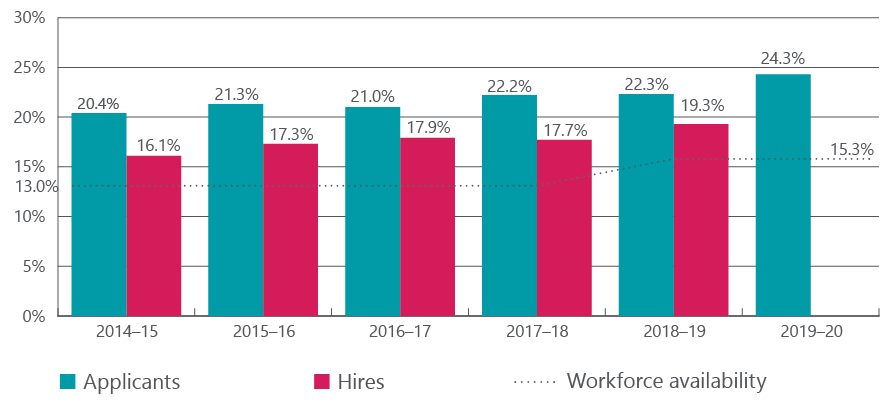
Text Alternative
Members of visible minorities applicants to advertised processes and hires compared to workforce availability (percentage) |
||||||
|---|---|---|---|---|---|---|
Fiscal year |
2014 to 2015 |
2015 to 2016 |
2016 to 2017 |
2017 to 2018 |
2018 to 2019 |
2019 to 2020 |
Applicants |
20.4% |
21.3% |
21.0% |
22.2% |
22.3% |
24.3% |
Hires |
16.1% |
17.3% |
17.9% |
17.7% |
19.3% |
- |
Workforce availability |
13.0% |
13.0% |
13.0% |
13.0% |
15.3% |
15.3% |
| Subgroup |
2018–19 applicants to external advertised processes |
2018–19 hires |
2019–20 applicants to external advertised processes |
2019–20 hires * |
|---|---|---|---|---|
| Black | 24.5% | 23.2% | 25.7% | - |
| Chinese | 10.8% | 12.2% | 10.2% | - |
| Filipino | 5.0% | 3.5% | 4.5% | - |
| Japanese | 0.4% | 0.5% | 0.4% | - |
| Korean | 1.5% | 1.5% | 1.5% | - |
| Non-white Latin American | 4.7% | 4.8% | 4.9% | - |
| Non-white West Asian, North African or Arab | 11.1% | 13.1% | 11.6% | - |
| Person of mixed origin | 4.4% | 9.1% | 4.6% | - |
| Southeast Asian | 2.7% | 4.2% | 2.8% | - |
| South Asian / East Indian | 24.2% | 16.2% | 24.5% | - |
| Other visible minority | 10.6% | 11.7% | 9.4% | - |
Engagement with the Federal Black Employee Caucus
In January 2018, the Federal Black Employee Caucus was formed to address issues faced by Black federal public servants. The group advocates for the collection of disaggregated employment equity data. It also aims to support the mental health of Black employees by working to reduce harassment and discrimination in the workplace.
In January 2020, the Public Service Commission of Canada established the Employment Equity Research Working Group in collaboration with the Federal Black Employee Caucus and 7 other federal government departments and agencies. The working group:
- provides us with feedback and advice to improve our data collection and reporting
- informs our coordinated approach to managing our employment equity responsibilities
- reflects our commitment to engage with members of employment equity groups to remove any barriers in the staffing system


Text Alternative
Women applicants to advertised processes and hires compared to workforce availability (percentage) |
||||
|---|---|---|---|---|
Fiscal year |
2016 to 2017 |
2017 to 2018 |
2018 to 2019 |
2019 to 2020 |
Applicants |
54.3% |
53.7% |
55.0% |
55.3% |
Hires |
57.7% |
58.7% |
56.5% |
- |
Workforce availability |
52.5% |
52.5% |
52.6% |
52.7% |
Renewal through diversity

The National Research Council of Canada is recruiting for diversity
The National Research Council of Canada’s Industrial Research Assistance Program is Canada’s leading innovation assistance program for small and medium-sized businesses. It is delivered nationally by over 255 industrial technology advisors and veteran research and development professionals.
To achieve its commitment to diverse hiring of mid-to-late career professionals, the program expanded its recruitment activities. For example, it introduced a social media outreach approach to target highly qualified and diverse candidates. As well, candidates, especially those from underrepresented groups, were given the opportunity to speak directly and confidentially with an industrial technology advisor to learn more about their role. Finally, every effort was made to match potential hires to advisors with similar technology, business, geographical, and/or designated employment equity group backgrounds who could provide feedback on the merit of the role.
Although this strategy was only implemented halfway through 2019–20, the results have been promising:
- 56% of applicants self-identified as part of an employment equity group, almost 3 times as many as the previous year
- 14 of 2019–20’s newly hired industrial technology advisors self-identified as part of an employment equity group, a 50% increase over the previous year
Although the National Research Council of Canada is not subject to the Public Service Employment Act, this strategy could be adapted and applied in other departments and agencies.
A key part of public service renewal starts in the early stages of one’s career, with student employment. Recognizing this vital source for future longer-term employment, we enhanced the Employment Opportunity for Students with Disabilities and the Indigenous Student Employment Opportunity programs by extending them year-round, and providing students with ongoing support, training and networking opportunities.
We also focused on diversity in this year’s Post-Secondary Recruitment campaign, tailoring outreach and promotion to increase applications from members of employment equity groups, particularly Indigenous candidates and candidates with disabilities. The efforts proved worthwhile, with a 14.4% increase in the number of Indigenous applicants and a 34.7% increase in applicants with disabilities.
In 2019–20, in collaboration with the Office of the Chief Human Resources Officer, we launched an Indigenous Career Pathway. This initiative provides tools to hiring managers, human resources advisors and Indigenous employees to help recruit, retain and develop Indigenous federal public servants. Under the initiative, to place more Indigenous Student Employment Opportunity participants, we established an inventory of 59 Indigenous candidates, available to all departments and agencies. This pool includes 34 Indigenous students who are available for re-hire, as well as 25 Indigenous graduates who are available for full-time opportunities. To date, 2 students and 4 graduates have been hired under the pathway, a modest beginning that we expect to build upon in the future.
The Atlantic Region Interdepartmental Indigenous Recruitment Initiative Working Group was also established to coordinate departmental efforts to increase the number of Atlantic Canada's Indigenous recruits. The working group is made up of regional representatives from Indigenous Services Canada, Fisheries and Oceans Canada, Environment and Climate Change Canada, Parks Canada, the Canada Revenue Agency, Public Services and Procurement Canada and the Public Service Commission of Canada. It is focused on broadening collaborative outreach to Indigenous communities and organizations, and sharing best practices in recruiting and retaining Indigenous peoples.
The Impact Assessment Agency of Canada is increasing representation
One of the Impact Assessment Agency of Canada’s priorities for 2019–20 was to increase employment equity representation within the agency. To design a process that was as inclusive and barrier-free as possible, they consulted with organizations responsible for integrating employment equity groups into the workplace. These organizations provided advice and guidance on merit criteria, exam content and the length of time the job poster should be open. With their help, the agency ran an externally advertised process targeting employment equity groups. The process generated more than 1 500 applicants from across Canada spanning all 4 employment equity groups, a record number of applicants for an externally advertised process with the agency. A pool of 541 partially qualified candidates was created; managers need only interview potential candidates to evaluate right fit and select their new employee. Since its creation, 4 candidates have been appointed from the pool, with more expected throughout the year.
An accessible public service

The Accessibility Strategy for the Public Service of Canada, launched by the Treasury Board of Canada Secretariat in May of 2019, provides a strong framework for Canada’s public service to identify, prevent and remove barriers in the staffing and recruitment of persons with disabilities. It is guided by the Accessible Canada Act, and serves as a roadmap to support the federal public service in becoming a model of accessibility.
One of the strategy’s key goals is to recruit 5 000 net new persons with disabilities over 5 years. To meet this target, accounting for retirements and other departures, the public service will need to hire up to 11 250 persons with disabilities. We will continue to support departments and agencies as they pilot innovative solutions to identify, remove and prevent accessibility barriers and increase the representation of persons with disabilities.
To support departments and agencies in achieving this goal, our student inventories had over 3 000 students with disabilities available for hire in 2019–20. An additional 640 graduates who self-declared as persons with disabilities were also available for hire in our Post-Secondary Recruitment inventory.
In 2019–20, we also launched the Federal Internship Program for Canadians with Disabilities. This national program provides 125 2-year federal public service internship opportunities over 5 years to Canadians with disabilities. Interns have the opportunity to improve their work skills and increase their employability through this developmental program. For the first cohort of the program, 20 interns were hired across 8 departments and agencies.
Increasing accessibility
In October 2019, the Public Service Commission of Canada conducted bilingual workshops at Careers in Government, an event led by Carleton University’s Research, Education, Accessibility and Design Initiative. This event for students with disabilities saw 168 students participate from Carleton University, the University of Ottawa, Algonquin College and La Cité college.
Our workshops focused on GC Jobs, the Post‑Secondary Recruitment campaign and the Federal Student Work Experience Program. Our staff and volunteers from the David C. Onley Initiative helped students create a Federal Student Work Experience Program profile.
We also helped federal departments and agencies match the students they met at the event with their Federal Student Work Experience Program job opportunities. We received more than 25 requests for students from departments and agencies, which resulted in 10 hires.
To promote these recruitment programs, we participated in 46 events, partnering with the Canadian Association for Supported Employment, the David C. Onley Initiative for Employment and Enterprise Development, the Canadian National Institute for the Blind, the Centre de recherche pour l’inclusion de personnes en situation de handicap and Spinal Cord Injury Ontario.
To cultivate a more accessible and inclusive public service, we also created a network of assessment accessibility ambassadors. The network helps hiring managers recruit persons with disabilities by sharing expertise on accessible recruitment strategies, unbiased assessment tools and accommodation measures. The ambassadors are human resources specialists working in their departments, trained by Public Service Commission assessment experts, with access to specialized material, information and advice. As of March 31, 2020, the expanding network had more than 50 ambassadors from 30 federal government departments and agencies.
Accommodation measures over time
The Public Service Commission of Canada offers assessment accommodation services to federal departments and agencies, and has fulfilled over 17 000 requests for assessment accommodation over the last 6 years. Over this period, requests have increased by 74%. Increases in requests for assessment accommodation due to psychological, emotional, psychiatric and attention-related limitations are especially notable: these requests have more than tripled.
In 2019–20, 17% of requests involved limitations related to psychological conditions, compared to 9% in 2013–14. Requests for accommodation measures related to learning disabilities have declined as a proportion of all requests, from 24% to 16% between 2013–14 and 2019–20. While many factors are at play, informal consultations suggest that the increased proportion of requests related to psychological limitations could be partly due to candidates’ greater comfort levels in revealing functional limitations related to emotions or anxiety, for example. This trend coincides with the federal public service’s increased focus on mental health, which may have reduced the stigma associated with psychological limitations.
Our regional presence Footnote 12
As of March 31, 2020, the total population (indeterminate, term, casual, and student) for departments and agencies subject to the Public Service Employment Act was up across all regions. Over the past 10 years, the federal public service population has remained consistently higher in the rest of Canada combined than in the National Capital Region; however, this gap has narrowed. The 10-year trend shows that the share of public servants in the National Capital Region has increased to 47.3% of the federal public service workforce as of March 31, 2020, up from 43.6% as of March 31, 2011.
This reflects a staffing imbalance in the federal public service: the share of public servants working in the National Capital Region is growing while the share of public servants working outside of the region is shrinking. The imbalance is also reflected in the ratio of new hires, with the National Capital Region accounting for 53.2% (30 537) of new hires (indeterminate, term, casual and student). The COVID-19 pandemic proves that the federal public service can successfully work virtually. A greater reliance on employees working remotely can improve our ability to reach talent anywhere in the country, and to draw on Canadians regardless of where they live. These perspectives can further increase our diversity and improve the public service as a whole.
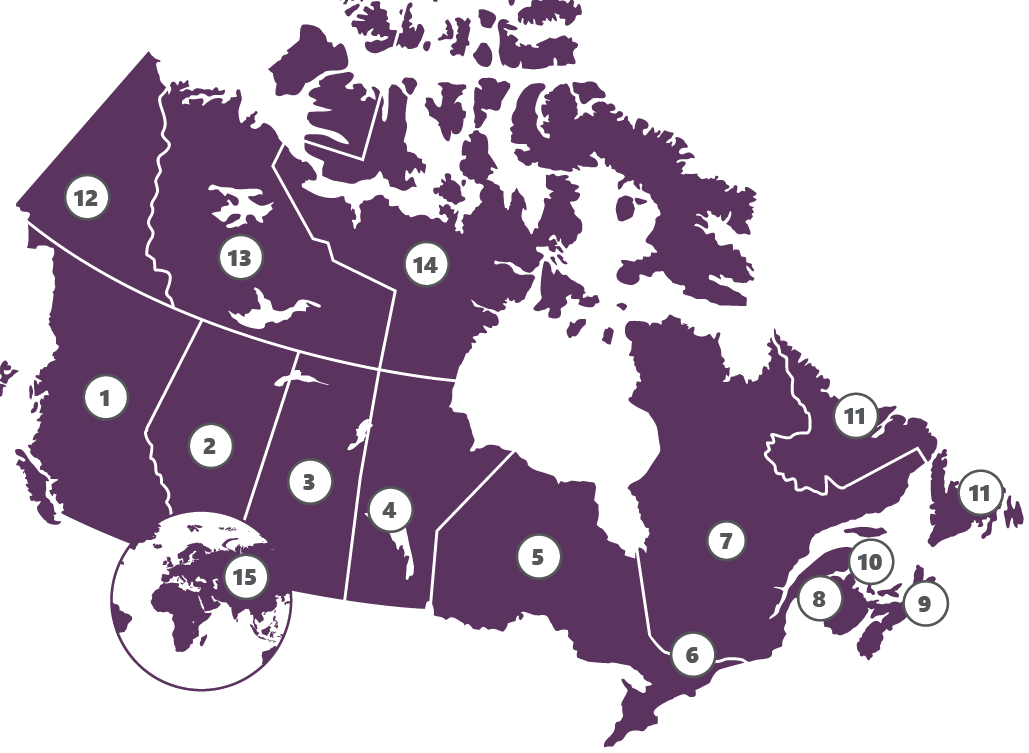
| Regions | Hires | PSEA population * |
|---|---|---|
| 1 British Columbia | 3 836 | 18 739 |
| 2 Alberta | 2 745 | 11 849 |
| 3 Saskatchewan | 1 130 | 5 051 |
| 4 Manitoba | 1 412 | 7 340 |
| 5 Ontario (except NCR) | 5 758 | 27 712 |
| 6 National Capital Region (NCR) | 30 537 | 109 261 |
| 7 Quebec (except NCR) | 5 331 | 23 877 |
| 8 New Brunswick | 2 072 | 9 044 |
| 9 Nova Scotia | 2 573 | 9 645 |
| 10 Prince Edward Island | 611 | 2 196 |
| 11 Newfoundland and Labrador | 971 | 3 781 |
| 12 Yukon | 98 | 346 |
| 13 Northwest Territories | 98 | 436 |
| 14 Nunavut | 103 | 259 |
| 15 International | 119 | 1 497 |
| Unknown | 4 400 | 1 943 |
*Public Service Employment Act population as of March 31, 2020
Canada’s linguistic duality
The federal public service serves Canadians across the country in the official language of their choice. In 2019–20, the Public Service Commission participated in 48 events with official languages minority communities across the country to:
- promote linguistic duality
- better understand the needs of those communities
- encourage members to apply to federal public service jobs

We will continue to look at leading practices and work with our partners to champion linguistic duality in the federal public service.
For example, after noticing that Francophone applicants dropped out of staffing processes in the National Capital Region at considerably higher rates than their Anglophone counterparts, Natural Resources Canada changed their approach to retain more Francophone applicants. Information about Francophone culture, locations and population growth in the National Capital Region, as well as a quote from the mayor of Ottawa detailing French culture in the region, were added to key sections in the job advertisement.
Based on these changes, the Francophone withdrawal rate decreased by 49%, without affecting the Anglophone applicant withdrawal rate. The experiment shows that small, low-effort changes to supporting text in job advertisements can have a major impact on job applicants.
A public service based on merit and non-partisanship
The Public Service Commission of Canada safeguards merit-based appointments and the non-partisanship of the federal public service. When the New Direction in Staffing was implemented in April 2016, deputy heads were given greater accountability and discretion to oversee staffing within their departments and agencies.
As part of this accountability, deputy heads must assess their department or agency’s staffing compliance with legislative and policy requirements at least once every 5 years, and report the results to the Public Service Commission. These cyclical assessments enable deputy heads to take a broad look at the health of their own staffing system.
We received 8 cyclical assessment reports from departments and agencies in 2019–20. The reports demonstrated a high degree of compliance with legislative and policy requirements.
This year, we started to work with 12 small departments and agencies, helping them to fulfil this mandatory requirement and strengthen their organizational oversight capacity. We also supported a number of departments and agencies in undertaking internal audits of staffing; in many cases, the results of these internal audits will be submitted as cyclical assessments. We will continue to report on cyclical assessment results in future annual reports.
Horizontal audits

We conduct horizontal audits to examine systemic staffing risks across the federal public service and to determine whether more guidance or support is required. In 2019–20, 2 horizontal audits were underway.
We started an audit of the Federal Student Work Experience Program to see if key requirements of the program are being met. The audit will also help us to understand how different departments and agencies hire students through the program, and provide an opportunity to improve these processes.
We are also conducting an audit on employment equity representation in recruitment to learn whether members of employment equity groups are proportionately represented throughout key stages of advertised external appointment processes. It will also examine what factors influence representation in the appointment system. The audit explores:
- how applicants from each of the 4 designated employment equity groups fare in the recruitment process compared to applicants from other employment equity groups or who do not belong to a group
- whether factors such as the types of assessment tools used, or previous work experience, have an impact on their success
Investigations
As part of our mandate to oversee the integrity of the staffing system and the political impartiality of the federal public service, we investigate concerns relating to specific appointment processes and allegations of improper political activities of federal public servants. This means that we investigate external appointment processes when there are concerns that:
- an appointment or proposed appointment may not have been based on merit
- there may have been an error, omission or improper conduct that affected the selection of the person appointed or proposed for appointment
We also investigate external and internal appointment processes when there are concerns that fraud may have occurred or that an appointment or proposed appointment may not have been free from political influence.
In 2019–20, we received 548 requests for investigations. Of these requests, it was determined that 257 fell under our mandate.
They included:
- 160 related to error, omission or improper conduct, or to merit not being met
- 68 related to fraud
- 29 related to improper political activities
- none related to political influence

Text Alternative
Number of founded investigations |
|||||
|---|---|---|---|---|---|
Fiscal year |
2015 to 2016 |
2016 to 2017 |
2017 to 2018 |
2018 to 2019 |
2019 to 2020 |
Fraud |
42 |
48 |
38 |
17 |
19 |
Error, omission or improper conduct |
3 |
5 |
5 |
4 |
6 |
Improper political activities |
1 |
3 |
2 |
7 |
20 |
The number of requests for investigations relating to fraud, error, omission or improper conduct, or to merit not being met during public service appointment processes was consistent in 2019–20 with previous years.
The number of allegations related to improper political activities increased from 18 in 2018–19, to 29 in 2019–20, largely because it was an election year that included a federal election and several provincial and municipal elections. In addition to these 29 new allegations, 10 were carried over from the previous year. Most involved a failure to seek and obtain permission from the Public Service Commission before running for office. Of these 39 investigations, 20 reached a founded conclusion and, when appropriate, corrective actions were ordered.
In 2019–20, we launched a series of outreach activities to raise awareness and help departments and agencies strengthen their investigations-related capacity. We delivered tailored workshops to help human resources professionals address the most common irregularities. The workshops also helped the human resources community prevent potential issues in appointment processes and to detect irregularities. We also collaborated with a group of federal departments and agencies to launch the Federal Government Investigators’ Community in February 2020. The community’s vision is to become a forum for investigators in the public service to share information, knowledge and experience on investigative techniques and best practices.
Non-partisanship and political activities
A non-partisan and professional public service is fundamental to a healthy democracy. Safeguarding this non-partisanship is central to our mandate. We ensure that public service employees serve the Canadian population, not a political party. A non-partisan public service means:
- appointments are made on the basis of merit, free from political influence
- programs and services are administered in a professional and non-partisan manner
- public service employees perform their duties in a politically impartial manner, and are perceived to do so
This does not mean that employees cannot express their political opinions or partake in political activities. Employees may consider seeking nomination or becoming a candidate in an election, donating to a political party, canvassing for a political candidate, or expressing their support for a political candidate on social media. In assessing whether they can engage in these activities, employees should examine their specific circumstances. Our online political activities resources offer information and guidance, as well as links to useful contacts. Public servants can draw on these to make informed decisions and to ensure that their activities do not impair, or are not perceived as impairing, their ability to perform their public service duties in a politically impartial manner.
Investigation finding: improper conduct (favouring a family member)
A senior executive committed improper conduct in an external non-advertised appointment process by participating in hiring their partner’s child without disclosing the relationship.
The senior executive was involved in many aspects of the appointment process, including:
- the decision to staff the position indeterminately (permanently) via a non-advertised appointment process instead of proceeding with casual employment
- the offer of a relocation allowance to the candidate
- the articulation of the selection decision
- the letter of offer
Following the conclusion of improper conduct in the appointment process, the Public Service Commission of Canada ordered:
- the revocation of the appointment
- the removal of the sub-delegated manager’s staffing authorities for a period of 5 years
- required training by the manager on values and ethics as well as staffing
Employees who are thinking about seeking nomination or becoming a candidate in a federal, provincial, territorial or municipal election must first request and obtain permission from the Public Service Commission. In assessing a request for permission, we consider many factors, including the nature of the election, the nature of the employee’s duties and the level and visibility of the public service position. Each request is assessed on a case-by-case basis. The assessment determines whether there is a risk to political impartiality. If we determine that there is a risk, to mitigate it, we will impose conditions that the employee must accept in order for the permission to be granted.
No requests for permission to seek nomination or to become a candidate were denied in 2019–20. Since 2005, when the legislation was revised to reflect this approach, only 9 requests for permission have been denied.
We do outreach to raise employees’ awareness about their rights and responsibilities relating to political activities. In 2019–20, over 45 information sessions on political activities and non-partisanship were delivered to various audiences. We also responded to 200 enquiries from public service employees and members of the public on a wide range of questions and issues related to the political engagement of public servants.
|
2019–20 candidacy permissions Footnote 13 |
||
|---|---|---|
|
Level |
Number of elections * |
Number of permissions granted |
|
Municipal |
14 |
16 |
|
Territorial |
1 |
1 |
|
Provincial |
3 |
3 |
|
Federal |
1 |
23 ** |
|
Total |
19 |
43 |
* Refers to elections and by-elections where a public servant sought permission.
** Refers to permissions granted only in 2019–20. In total, from 2017 to 2019, 36 permissions were granted for the 2019 federal election.
Social media and political activities

At all times, public servants are expected to perform their duties in a politically impartial manner, and be perceived to do so. Social media platforms provide an easy way to engage in political activities. However, expressing political views on social media may impair, or be perceived as impairing, an employee’s ability to perform their public service duties in a politically impartial manner. Before undertaking activities in support of, or in opposition to, a political party or candidate on social media, employees should assess the risk to political impartiality. Federal public servants should consider the following factors before engaging in political activities on social media:
- messages can be shared with a large audience almost instantly
- messages can be taken out of context, and users may not be able to control how content will be used and interpreted
- permanent digital footprint means it can be difficult to remove content
- private messages can become public regardless of privacy settings
Looking forward
The Public Service Commission of Canada plays an important role in building the Government of Canada’s workforce and in maintaining Canadians’ trust in the federal public service. While efforts to modernize staffing were already well underway, the COVID-19 pandemic has underscored the importance of modernization and spurred us to fast-track progress and leverage technological advances.
The rise of virtual work offers a tremendous opportunity to increase diversity in the federal public service. The ability to bring jobs to employees, rather than employees to jobs, opens the doors to Canadians from underrepresented communities and regions. This being said, our drive to innovate in staffing must be aligned with our progress on accessibility, diversity and inclusion, while maintaining our steadfast commitment to uphold merit in the hiring process.
We are pursuing the expansion of unsupervised internet testing and testing from home. Allowing candidates to use accessible technology in the assessment process reinforces diversity and inclusion, and it also highlights our commitment to innovating the staffing process.
In the year ahead, we will continue to explore leading practices and emerging technologies from the private sector, and seek inspiration in from other jurisdictions. We have already embarked on an ambitious redesign of our recruitment system, the GC Jobs portal, through which all Canadians can access jobs in the federal public service. We will ensure that it harnesses all the potential of digital technology to:
- help managers continue to build a talented, diverse, and inclusive public service
- support public service renewal
- improve the experience of those applying for public service jobs
We will strengthen our efforts to advance diversity and inclusion in the public service workforce. This past year saw the release of new workforce availability estimates for the 4 employment equity designated groups. A number of areas require our sustained attention, particularly increasing the representation of Indigenous peoples and persons with disabilities. We will expand on existing hiring programs to attract and retain more members of these groups. We will also focus on accessibility as we explore ways to reduce barriers in the hiring process.

However, we recognize that more needs to be done to make Canada's federal public service more inclusive and diverse. This will mean:
- creating inclusive talent-sourcing strategies for women, Indigenous people, members of visible minorities and persons with disabilities
- looking for diverse talent in groups beyond traditional employment equity categories, for example, reaching out to members of LGBTQ2+ communities
- systematically identifying and removing barriers to equality
- providing accommodation measures in the workplace that allow every public servant to fully contribute to the best of their abilities
- recognizing that diversity of thought leads to better outcomes
This is a collective effort, and while we are eager to work with our partners to foster a more diverse and inclusive public service, it is the decisions of hiring managers that will eventually lead to success.
The year 2021 will mark the 5-year anniversary of the New Direction in Staffing and new hiring provisions for veterans in the Public Service Employment Act. We plan to work with all departments and agencies to harness the staffing policy framework so that we can improve our approach to recruitment and attract the talent, including medically released veterans, who will serve Canadians well.
In this evolving landscape, the Public Service Commission of Canada’s role is more crucial than ever, both to ensure that merit and non-partisanship are upheld, and to bring about the modernization required to build tomorrow’s public service.
General note
Unless stated otherwise, all data reflects 2019–20 population and staffing activities to and within departments and agencies subject to the Public Service Employment Act. This does not include separate agencies such as the Canada Revenue Agency, the Canadian Food Inspection Agency and Parks Canada.
Additional information is available on the Open Government portal.
For more information, please contact:
The Public Service Commission of Canada
22 Eddy Street, Gatineau, Quebec K1A 0M7
cfp.infocom.psc@cfp-psc.gc.ca
Twitter: @PSCofCanada
This report is also available on our website at https://www.canada.ca/en/public-service-commission.html
Catalogue No.: SC1E-PDF
ISSN: 1912-0842
© Her Majesty the Queen in Right of Canada, represented by the Public Service Commission of Canada, 2020

